Project Methodology Report: Waterfall, PMBOK, and PLC Analysis
VerifiedAdded on 2021/04/16
|7
|1316
|62
Report
AI Summary
This report provides a comprehensive overview of project methodologies, focusing on the Waterfall model and the PMBOK (Project Management Body of Knowledge) methodology. It defines project management and project methodology, outlining the five phases of project management: initiation, planning, executing, monitoring and controlling, and closing. The report contrasts the Waterfall model, which is a sequential approach with defined phases, with the PMBOK methodology, which offers a standardized set of project management processes and techniques. The report also discusses the Project Life Cycle (PLC) and its phases within the Waterfall model, including requirements, design, construction, testing, installation, and maintenance. The advantages and disadvantages of the Waterfall model are examined, highlighting its suitability for projects with low uncertainty and high dependency, while also acknowledging its limitations in terms of flexibility and customer involvement. The PMBOK methodology is presented as a framework for standardizing project management tasks. The report concludes by emphasizing the complementary nature of the Waterfall model for design and development, and the PMBOK for managing development processes effectively. The report includes references to relevant academic sources.
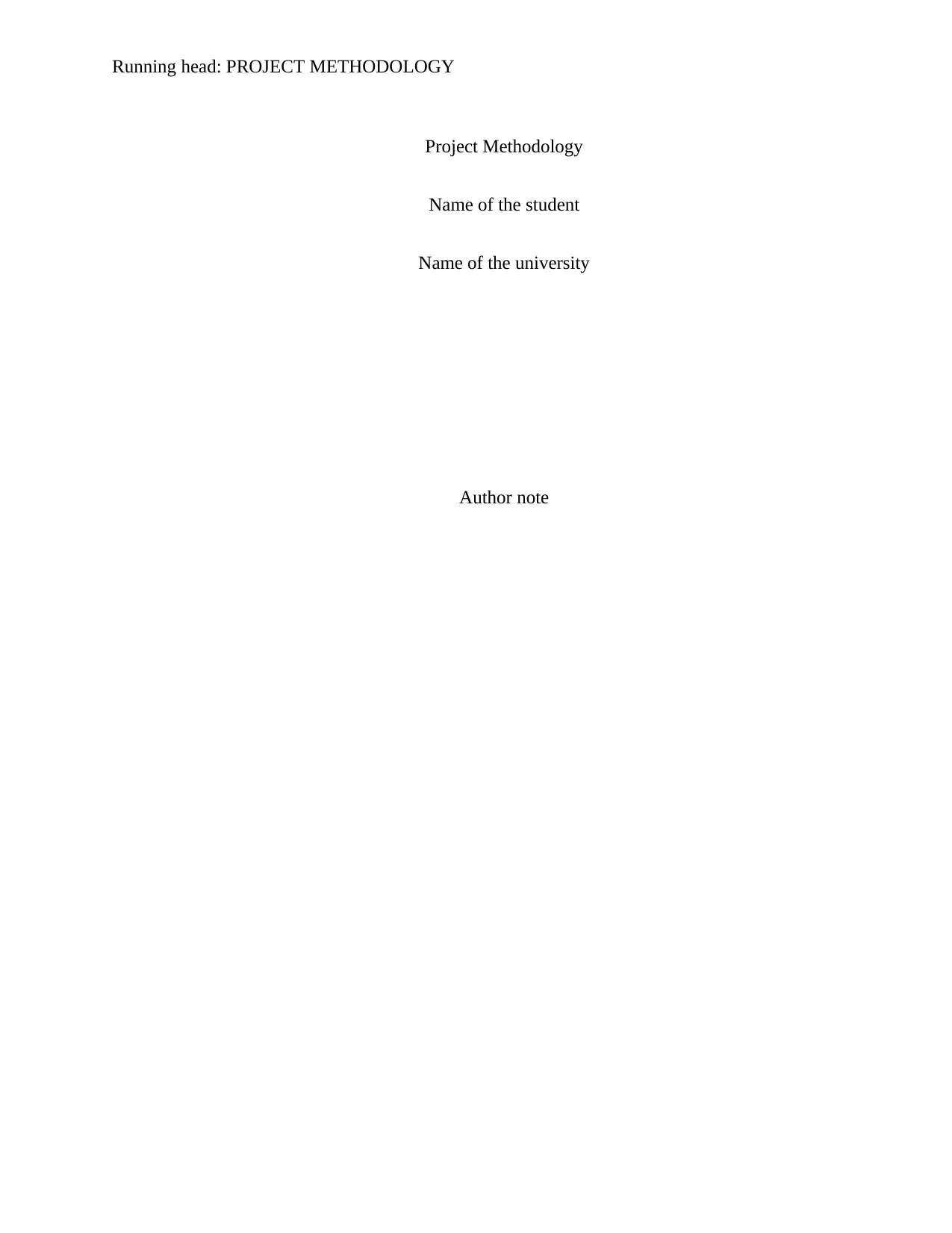
Running head: PROJECT METHODOLOGY
Project Methodology
Name of the student
Name of the university
Author note
Project Methodology
Name of the student
Name of the university
Author note
Paraphrase This Document
Need a fresh take? Get an instant paraphrase of this document with our AI Paraphraser
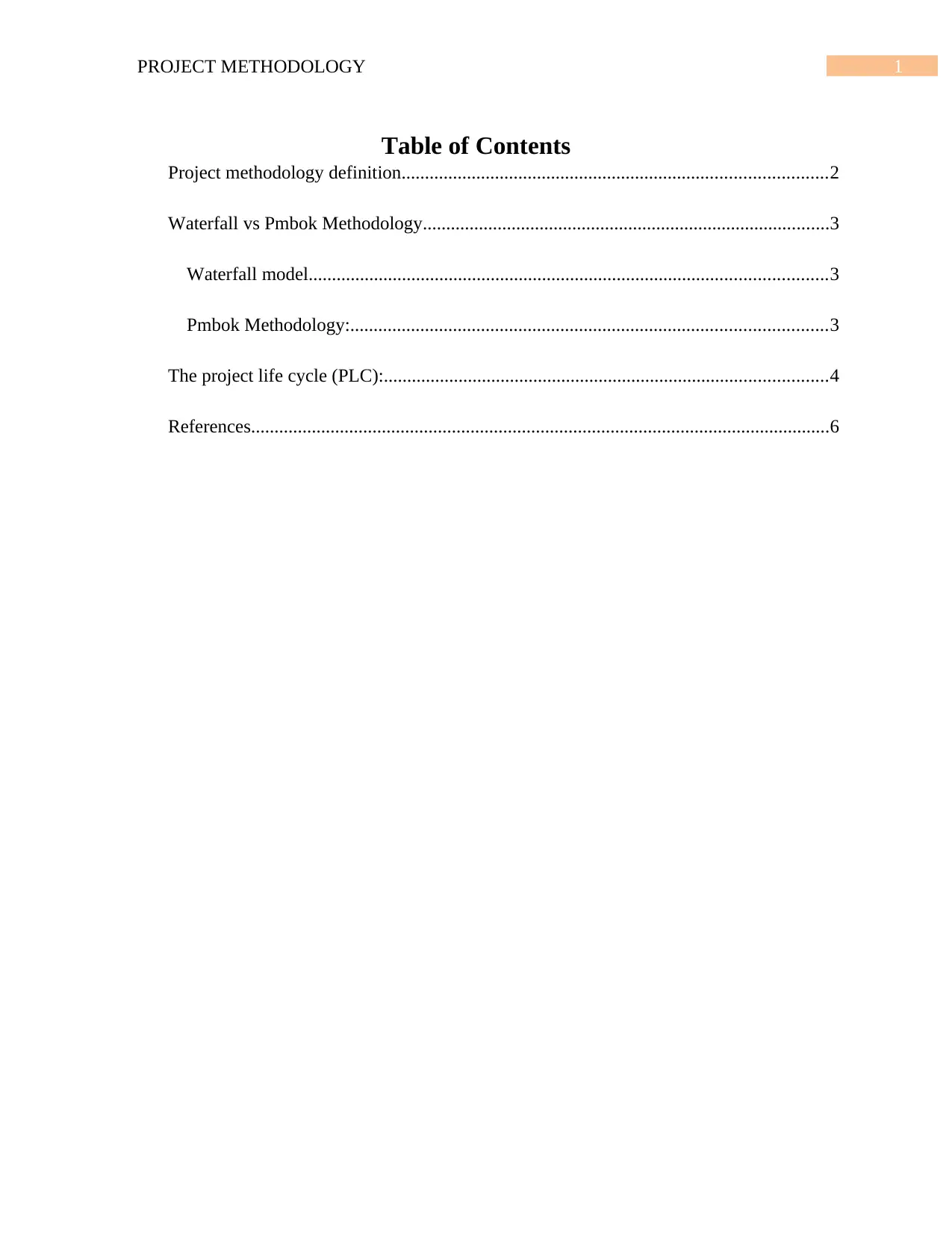
1PROJECT METHODOLOGY
Table of Contents
Project methodology definition...........................................................................................2
Waterfall vs Pmbok Methodology.......................................................................................3
Waterfall model...............................................................................................................3
Pmbok Methodology:......................................................................................................3
The project life cycle (PLC):...............................................................................................4
References............................................................................................................................6
Table of Contents
Project methodology definition...........................................................................................2
Waterfall vs Pmbok Methodology.......................................................................................3
Waterfall model...............................................................................................................3
Pmbok Methodology:......................................................................................................3
The project life cycle (PLC):...............................................................................................4
References............................................................................................................................6
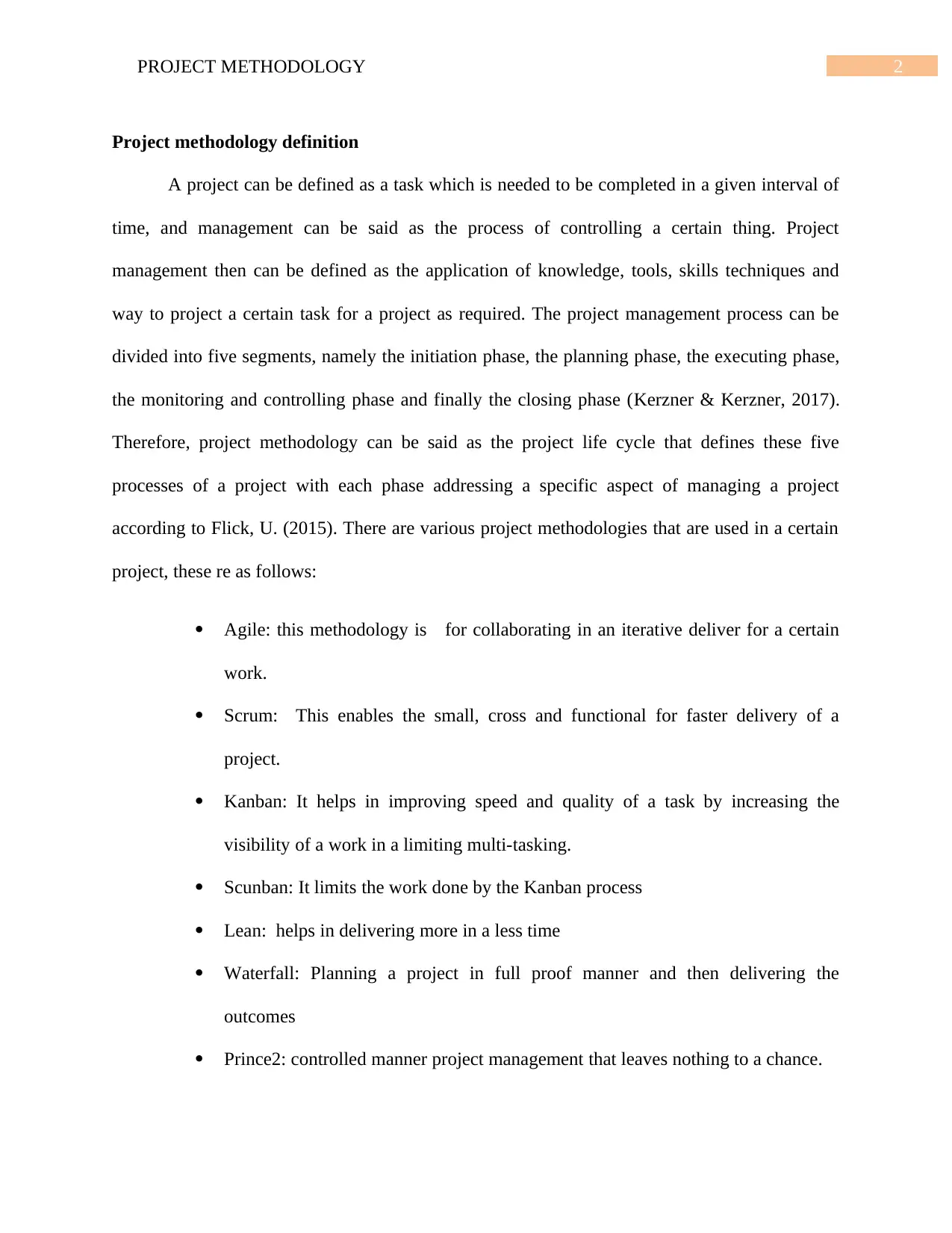
2PROJECT METHODOLOGY
Project methodology definition
A project can be defined as a task which is needed to be completed in a given interval of
time, and management can be said as the process of controlling a certain thing. Project
management then can be defined as the application of knowledge, tools, skills techniques and
way to project a certain task for a project as required. The project management process can be
divided into five segments, namely the initiation phase, the planning phase, the executing phase,
the monitoring and controlling phase and finally the closing phase (Kerzner & Kerzner, 2017).
Therefore, project methodology can be said as the project life cycle that defines these five
processes of a project with each phase addressing a specific aspect of managing a project
according to Flick, U. (2015). There are various project methodologies that are used in a certain
project, these re as follows:
Agile: this methodology is for collaborating in an iterative deliver for a certain
work.
Scrum: This enables the small, cross and functional for faster delivery of a
project.
Kanban: It helps in improving speed and quality of a task by increasing the
visibility of a work in a limiting multi-tasking.
Scunban: It limits the work done by the Kanban process
Lean: helps in delivering more in a less time
Waterfall: Planning a project in full proof manner and then delivering the
outcomes
Prince2: controlled manner project management that leaves nothing to a chance.
Project methodology definition
A project can be defined as a task which is needed to be completed in a given interval of
time, and management can be said as the process of controlling a certain thing. Project
management then can be defined as the application of knowledge, tools, skills techniques and
way to project a certain task for a project as required. The project management process can be
divided into five segments, namely the initiation phase, the planning phase, the executing phase,
the monitoring and controlling phase and finally the closing phase (Kerzner & Kerzner, 2017).
Therefore, project methodology can be said as the project life cycle that defines these five
processes of a project with each phase addressing a specific aspect of managing a project
according to Flick, U. (2015). There are various project methodologies that are used in a certain
project, these re as follows:
Agile: this methodology is for collaborating in an iterative deliver for a certain
work.
Scrum: This enables the small, cross and functional for faster delivery of a
project.
Kanban: It helps in improving speed and quality of a task by increasing the
visibility of a work in a limiting multi-tasking.
Scunban: It limits the work done by the Kanban process
Lean: helps in delivering more in a less time
Waterfall: Planning a project in full proof manner and then delivering the
outcomes
Prince2: controlled manner project management that leaves nothing to a chance.
⊘ This is a preview!⊘
Do you want full access?
Subscribe today to unlock all pages.

Trusted by 1+ million students worldwide
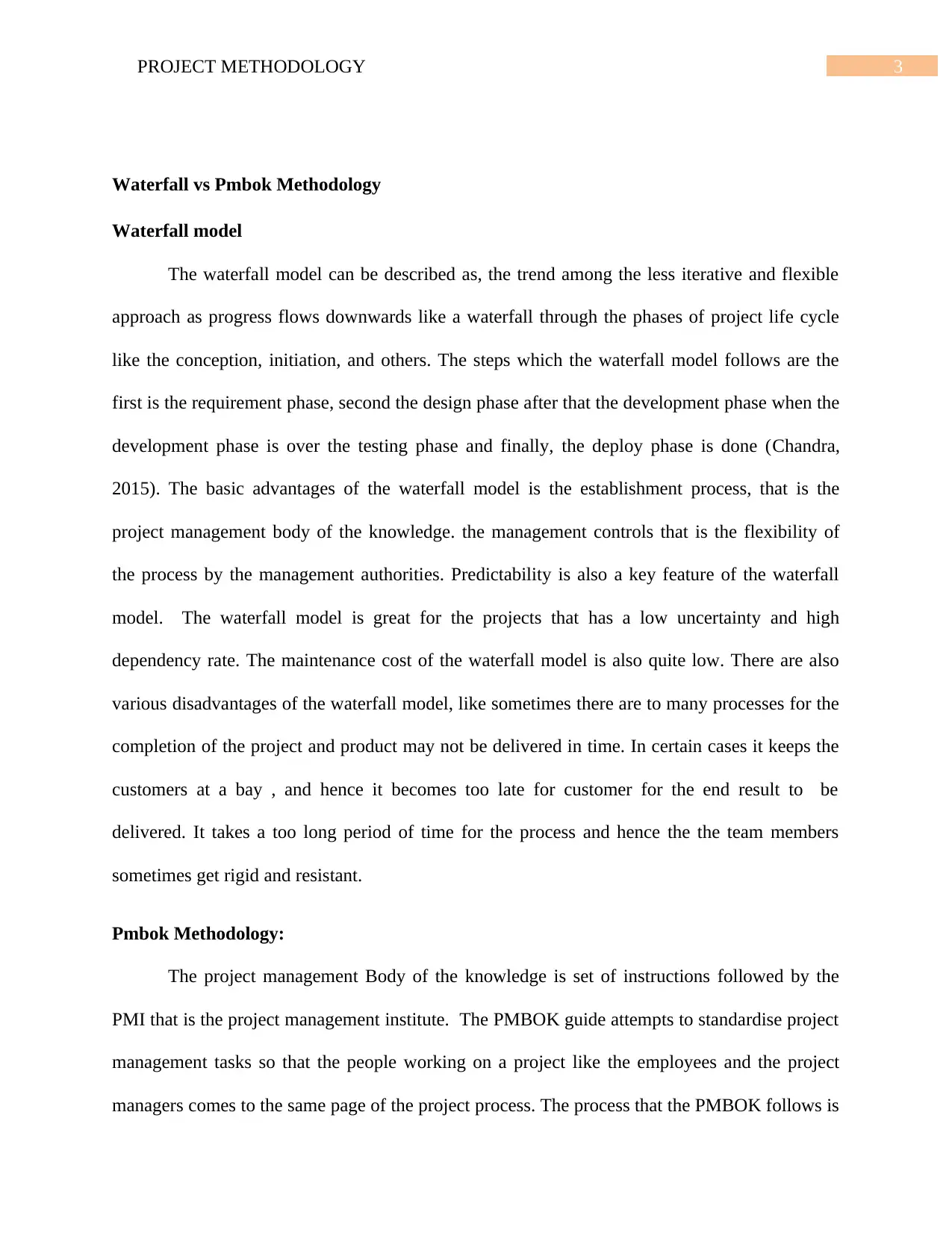
3PROJECT METHODOLOGY
Waterfall vs Pmbok Methodology
Waterfall model
The waterfall model can be described as, the trend among the less iterative and flexible
approach as progress flows downwards like a waterfall through the phases of project life cycle
like the conception, initiation, and others. The steps which the waterfall model follows are the
first is the requirement phase, second the design phase after that the development phase when the
development phase is over the testing phase and finally, the deploy phase is done (Chandra,
2015). The basic advantages of the waterfall model is the establishment process, that is the
project management body of the knowledge. the management controls that is the flexibility of
the process by the management authorities. Predictability is also a key feature of the waterfall
model. The waterfall model is great for the projects that has a low uncertainty and high
dependency rate. The maintenance cost of the waterfall model is also quite low. There are also
various disadvantages of the waterfall model, like sometimes there are to many processes for the
completion of the project and product may not be delivered in time. In certain cases it keeps the
customers at a bay , and hence it becomes too late for customer for the end result to be
delivered. It takes a too long period of time for the process and hence the the team members
sometimes get rigid and resistant.
Pmbok Methodology:
The project management Body of the knowledge is set of instructions followed by the
PMI that is the project management institute. The PMBOK guide attempts to standardise project
management tasks so that the people working on a project like the employees and the project
managers comes to the same page of the project process. The process that the PMBOK follows is
Waterfall vs Pmbok Methodology
Waterfall model
The waterfall model can be described as, the trend among the less iterative and flexible
approach as progress flows downwards like a waterfall through the phases of project life cycle
like the conception, initiation, and others. The steps which the waterfall model follows are the
first is the requirement phase, second the design phase after that the development phase when the
development phase is over the testing phase and finally, the deploy phase is done (Chandra,
2015). The basic advantages of the waterfall model is the establishment process, that is the
project management body of the knowledge. the management controls that is the flexibility of
the process by the management authorities. Predictability is also a key feature of the waterfall
model. The waterfall model is great for the projects that has a low uncertainty and high
dependency rate. The maintenance cost of the waterfall model is also quite low. There are also
various disadvantages of the waterfall model, like sometimes there are to many processes for the
completion of the project and product may not be delivered in time. In certain cases it keeps the
customers at a bay , and hence it becomes too late for customer for the end result to be
delivered. It takes a too long period of time for the process and hence the the team members
sometimes get rigid and resistant.
Pmbok Methodology:
The project management Body of the knowledge is set of instructions followed by the
PMI that is the project management institute. The PMBOK guide attempts to standardise project
management tasks so that the people working on a project like the employees and the project
managers comes to the same page of the project process. The process that the PMBOK follows is
Paraphrase This Document
Need a fresh take? Get an instant paraphrase of this document with our AI Paraphraser
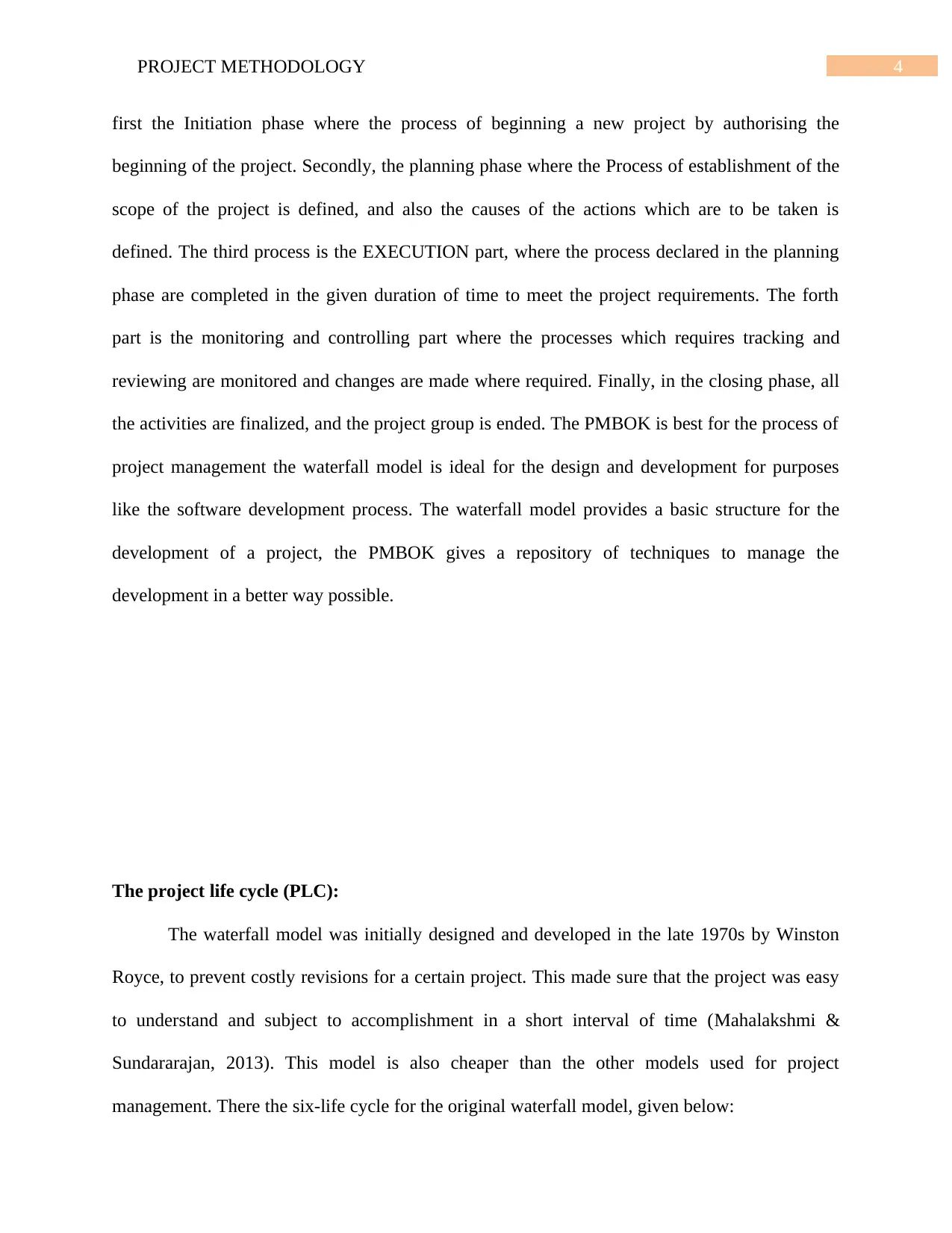
4PROJECT METHODOLOGY
first the Initiation phase where the process of beginning a new project by authorising the
beginning of the project. Secondly, the planning phase where the Process of establishment of the
scope of the project is defined, and also the causes of the actions which are to be taken is
defined. The third process is the EXECUTION part, where the process declared in the planning
phase are completed in the given duration of time to meet the project requirements. The forth
part is the monitoring and controlling part where the processes which requires tracking and
reviewing are monitored and changes are made where required. Finally, in the closing phase, all
the activities are finalized, and the project group is ended. The PMBOK is best for the process of
project management the waterfall model is ideal for the design and development for purposes
like the software development process. The waterfall model provides a basic structure for the
development of a project, the PMBOK gives a repository of techniques to manage the
development in a better way possible.
The project life cycle (PLC):
The waterfall model was initially designed and developed in the late 1970s by Winston
Royce, to prevent costly revisions for a certain project. This made sure that the project was easy
to understand and subject to accomplishment in a short interval of time (Mahalakshmi &
Sundararajan, 2013). This model is also cheaper than the other models used for project
management. There the six-life cycle for the original waterfall model, given below:
first the Initiation phase where the process of beginning a new project by authorising the
beginning of the project. Secondly, the planning phase where the Process of establishment of the
scope of the project is defined, and also the causes of the actions which are to be taken is
defined. The third process is the EXECUTION part, where the process declared in the planning
phase are completed in the given duration of time to meet the project requirements. The forth
part is the monitoring and controlling part where the processes which requires tracking and
reviewing are monitored and changes are made where required. Finally, in the closing phase, all
the activities are finalized, and the project group is ended. The PMBOK is best for the process of
project management the waterfall model is ideal for the design and development for purposes
like the software development process. The waterfall model provides a basic structure for the
development of a project, the PMBOK gives a repository of techniques to manage the
development in a better way possible.
The project life cycle (PLC):
The waterfall model was initially designed and developed in the late 1970s by Winston
Royce, to prevent costly revisions for a certain project. This made sure that the project was easy
to understand and subject to accomplishment in a short interval of time (Mahalakshmi &
Sundararajan, 2013). This model is also cheaper than the other models used for project
management. There the six-life cycle for the original waterfall model, given below:
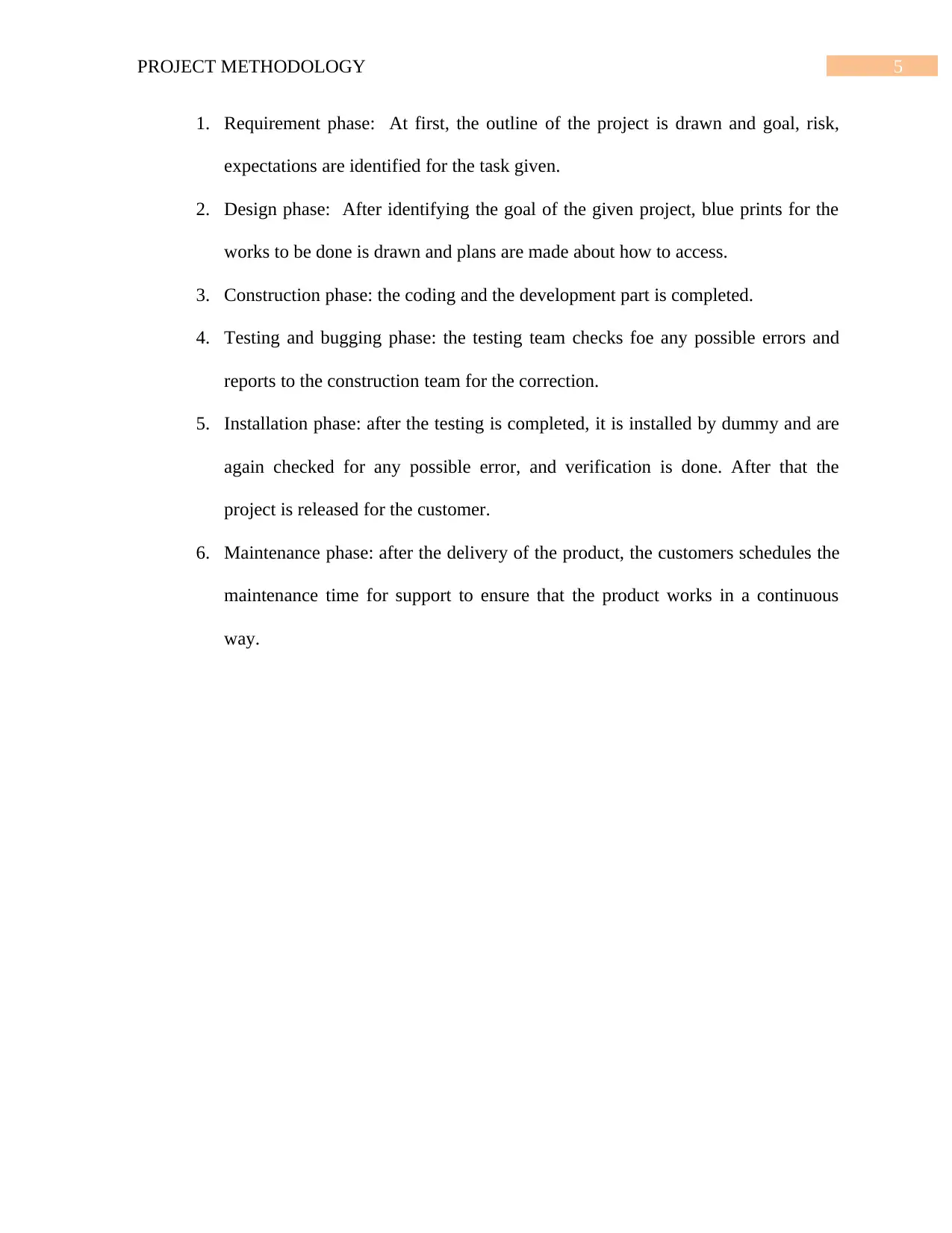
5PROJECT METHODOLOGY
1. Requirement phase: At first, the outline of the project is drawn and goal, risk,
expectations are identified for the task given.
2. Design phase: After identifying the goal of the given project, blue prints for the
works to be done is drawn and plans are made about how to access.
3. Construction phase: the coding and the development part is completed.
4. Testing and bugging phase: the testing team checks foe any possible errors and
reports to the construction team for the correction.
5. Installation phase: after the testing is completed, it is installed by dummy and are
again checked for any possible error, and verification is done. After that the
project is released for the customer.
6. Maintenance phase: after the delivery of the product, the customers schedules the
maintenance time for support to ensure that the product works in a continuous
way.
1. Requirement phase: At first, the outline of the project is drawn and goal, risk,
expectations are identified for the task given.
2. Design phase: After identifying the goal of the given project, blue prints for the
works to be done is drawn and plans are made about how to access.
3. Construction phase: the coding and the development part is completed.
4. Testing and bugging phase: the testing team checks foe any possible errors and
reports to the construction team for the correction.
5. Installation phase: after the testing is completed, it is installed by dummy and are
again checked for any possible error, and verification is done. After that the
project is released for the customer.
6. Maintenance phase: after the delivery of the product, the customers schedules the
maintenance time for support to ensure that the product works in a continuous
way.
⊘ This is a preview!⊘
Do you want full access?
Subscribe today to unlock all pages.

Trusted by 1+ million students worldwide
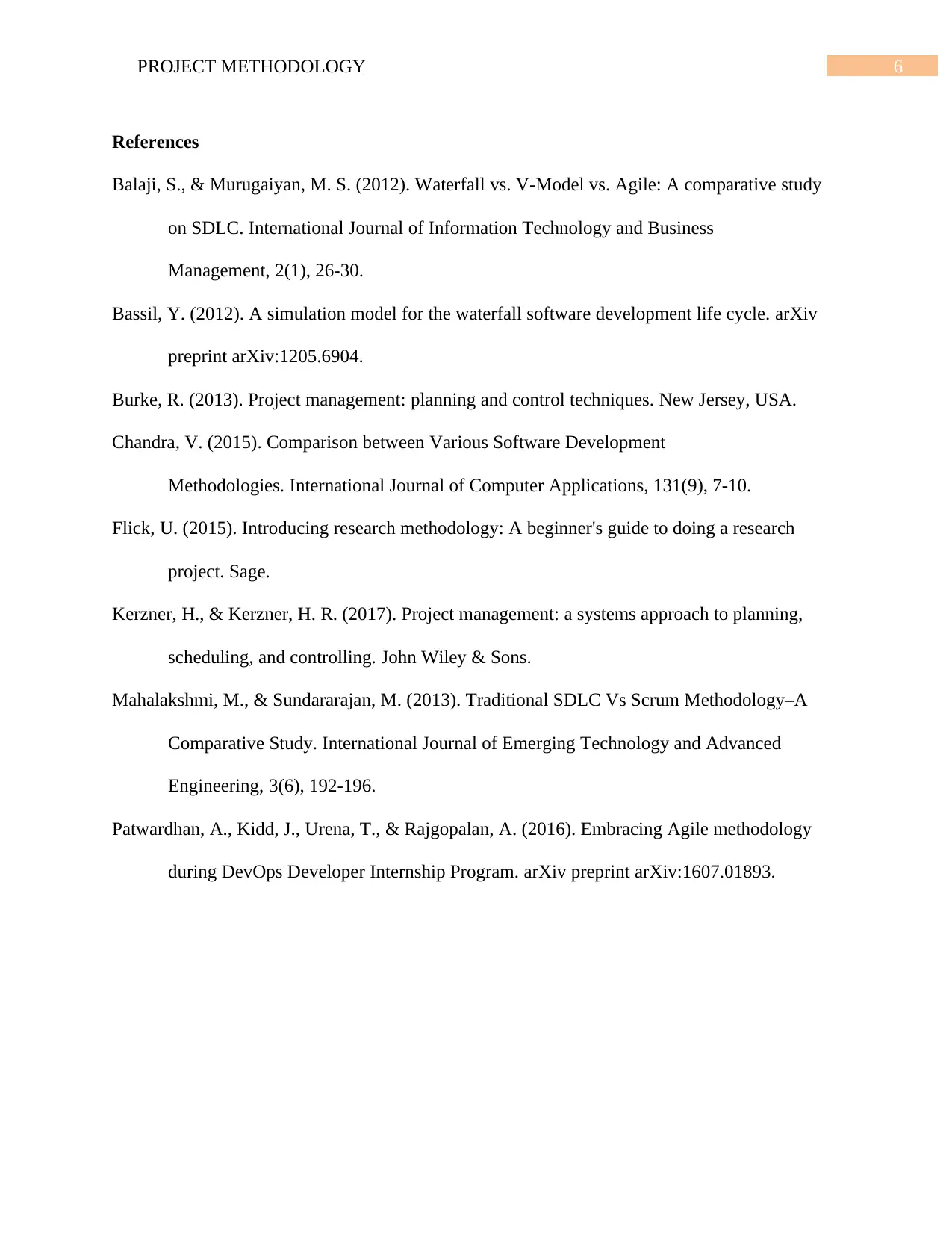
6PROJECT METHODOLOGY
References
Balaji, S., & Murugaiyan, M. S. (2012). Waterfall vs. V-Model vs. Agile: A comparative study
on SDLC. International Journal of Information Technology and Business
Management, 2(1), 26-30.
Bassil, Y. (2012). A simulation model for the waterfall software development life cycle. arXiv
preprint arXiv:1205.6904.
Burke, R. (2013). Project management: planning and control techniques. New Jersey, USA.
Chandra, V. (2015). Comparison between Various Software Development
Methodologies. International Journal of Computer Applications, 131(9), 7-10.
Flick, U. (2015). Introducing research methodology: A beginner's guide to doing a research
project. Sage.
Kerzner, H., & Kerzner, H. R. (2017). Project management: a systems approach to planning,
scheduling, and controlling. John Wiley & Sons.
Mahalakshmi, M., & Sundararajan, M. (2013). Traditional SDLC Vs Scrum Methodology–A
Comparative Study. International Journal of Emerging Technology and Advanced
Engineering, 3(6), 192-196.
Patwardhan, A., Kidd, J., Urena, T., & Rajgopalan, A. (2016). Embracing Agile methodology
during DevOps Developer Internship Program. arXiv preprint arXiv:1607.01893.
References
Balaji, S., & Murugaiyan, M. S. (2012). Waterfall vs. V-Model vs. Agile: A comparative study
on SDLC. International Journal of Information Technology and Business
Management, 2(1), 26-30.
Bassil, Y. (2012). A simulation model for the waterfall software development life cycle. arXiv
preprint arXiv:1205.6904.
Burke, R. (2013). Project management: planning and control techniques. New Jersey, USA.
Chandra, V. (2015). Comparison between Various Software Development
Methodologies. International Journal of Computer Applications, 131(9), 7-10.
Flick, U. (2015). Introducing research methodology: A beginner's guide to doing a research
project. Sage.
Kerzner, H., & Kerzner, H. R. (2017). Project management: a systems approach to planning,
scheduling, and controlling. John Wiley & Sons.
Mahalakshmi, M., & Sundararajan, M. (2013). Traditional SDLC Vs Scrum Methodology–A
Comparative Study. International Journal of Emerging Technology and Advanced
Engineering, 3(6), 192-196.
Patwardhan, A., Kidd, J., Urena, T., & Rajgopalan, A. (2016). Embracing Agile methodology
during DevOps Developer Internship Program. arXiv preprint arXiv:1607.01893.
1 out of 7
Related Documents
Your All-in-One AI-Powered Toolkit for Academic Success.
+13062052269
info@desklib.com
Available 24*7 on WhatsApp / Email
![[object Object]](/_next/static/media/star-bottom.7253800d.svg)
Unlock your academic potential
Copyright © 2020–2025 A2Z Services. All Rights Reserved. Developed and managed by ZUCOL.



